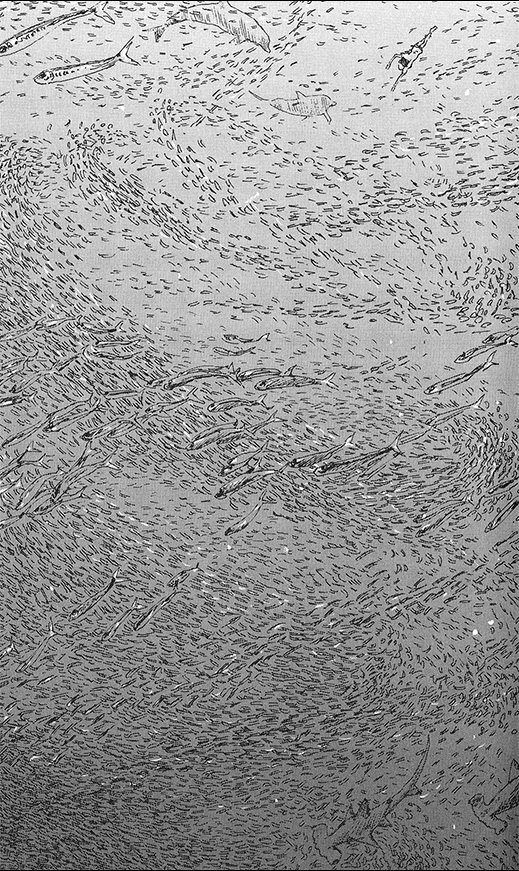Children of the Sea
When I was in second grade, my class took a weekend trip to Catalina Island off the coast of Southern California. It was Spring 1982 and we stayed at a marine institute. I had always been familiar with the island as a distant portion of our smog-soaked skyline,11Those of you who visit the coast of Southern California today are greeted with crisp blue skies after the marine layer burns off by noon. Smog so thick it'd make your lungs hurt and your eyes burn is a thing of the past. Since the implementation of environmental protections, our air is surprisingly worthwhile. Whenever I hear people talk about EPA regulation as some terrible, mismanaged elder beast, I simply point out: But hey, you can breathe and isn't that something?
From the land where my house used to stand in the '80s, one can make out the details of the island with astonishing clarity across the intervening water. When I was a kid, a Catalina sighting was a fifty-fifty bet and a crisp vision of the island a rare treasure. More often than not, the entire land mass was obscured by the thick brown-olive band of quote-unquote air that divided the waters below from the waters above—Los Angeles' own industrious attempt at reinventing the idea of firmament. but this would be different. We had spent the better part of our Spring trimester studying the marine life local to Southern California. We were going out to it in a way that our own tide pools rendered impossible. Limpets, urchins, sea cucumbers, anemone, sea hares, sharks, eels, plankton. Who knew what else. I was blisteringly excited for the opportunity. And it met and exceeded my expectations.
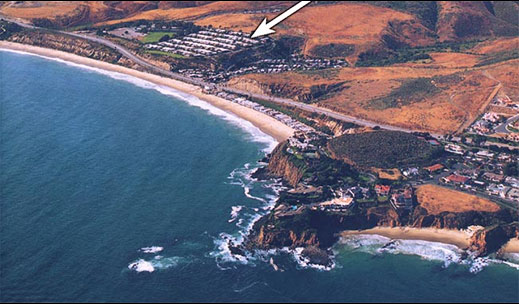 This is where I grew up.
This is where I grew up.
Having grown up pretty much on the beach (a one-and-a-half–minute walk from it at any rate), I’ve long held a certain affection for the sea and all it holds. While a special joy for me surrounded the quality of the morning salt air that hangs so heavily in coastal regions, the creatures that inhabit the ocean—both at depth and in shallows—also struck a deep chord of interest. I've always been tied up in a romance with the ocean (my last eight land-locked years notwithstanding), but getting off that boat and stepping onto the dock in Avalon a little more than three decades ago was deeply affecting. I was for the first time seeing bright sea creatures outside the confines of an aquarium. The moment my foot hit the planks, I could make out the sunshine orange of garibaldi flirting beneath the surface. It was incredible and was indicative of the next forty-eight hours of attending presentations, handling marine life, snorkeling, and generally basking in the miracle of the sea.
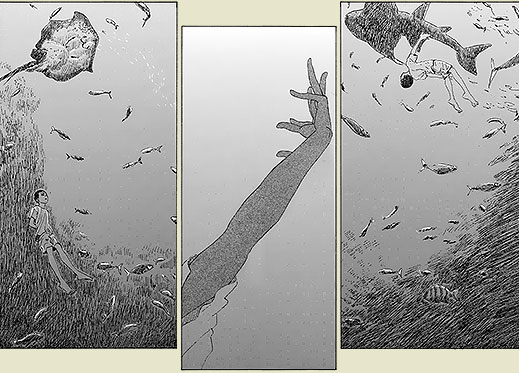
Sadly, as I grew older and other concerns began to jockey for my attention, I experienced a waning of interest in the sea as anything other than the locale of some of my favourite youthful pastimes22Principally these included boogieboarding and then skimboarding. The vast majority of my life's potentially lethal experiences revolved around these two activities.. It’s not that the undersea world no longer held any interest, but more that the magic of girls and videogames and comics were novelties expressing an entirely more visceral kind of power over me. I still found sea hares, -horses, and -cucumbers completely intriguing, but there was this wholly other kind of unshakeable mystery wrapped up in the lines, curves, and movements of Lori Loughlin, Kathy Ireland, and the woman on the car in that Whitesnake video. Sea cucumbers, for all their strange wonder, really couldn’t compare.
When I first saw Children of the Sea on a shelf at Borders several years ago, I was intrigued by the physical mass of the book. It sat unobtrusively on the shelf alongside the other manga digests. There was only a single copy available, dwarfed in number by more popular (and now I know, more banal) series. It was, however, nearly twice as thick as the average manga volume—which helped it stand out. Picking it up, my early love affair with the oceans and their bountiful life came rushing back. This book was clearly something special.33 VIZ’s Signature line continues to distribute worthwhile books, series that challenge popular or common notions of what the medium is capable of or best-suited for. While most of the medium still adheres pretty strongly to genre conventions (crime, romance, superheroes, autobio, sports, horror, et cetera), there are still some books that seek to craft something truly literary. It’s easy to recommend a book to someone who likes noir detective stories, books chronicling the zombie-apocalypse, or even Austen-esque period romance. What’s difficult is when a friend tells me they like the works of Bolaño or Murakami or Hemingway or Salinger or David Foster Wallace or Alice Munro and would like to read a graphic novel in similar vein. These friends aren’t looking for a particular plotline. Instead, they’re looking for something thoughtful, critical. They’re looking for something that looks at the world and has something to say. They’re looking for more of what they like: challenging literature. And while I wish I could easily rattle off a list of comics that land squarely in that kind of category, it’s a pretty tall order. Certainly things are getting better and there’s more of interest available now than there was ten years ago, but the truly worthy books grow pretty sparse along the comics landscape. Fortunately, Children of the Sea just might be another entrant into that canon of valuable, interesting books that defies genre classification and holds its own as a thoughtful approach to the world. And now that the series has at last concluded and its five volumes have secured roughly six inches of shelf space, I'm so very grateful to have noticed it all those years ago. This is one of my most treasured comics stories.
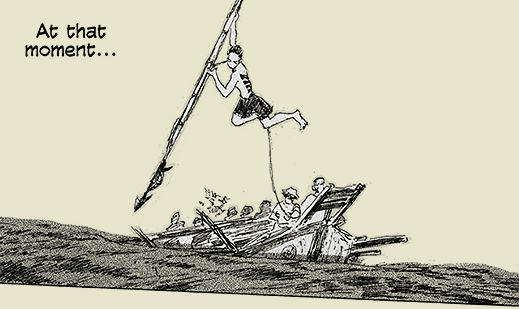 Poke.
Poke.
Children of the Sea is in surface the story of two young teens: Ruka and Umi. Ruka appears the rather typical daughter of a broken family. She lives with her mother but hides out at her father’s aquarium. Umi is a boy who, along with his brother Sora, was found as a toddler being raised by a pod of dugongs. Both Umi and Sora are more at home in the water than on land and their bodies have specially adapted to deep-sea free diving and swimming incredibly long distances with an ease unheard of by normal humans. Ruka shares with them a special kind of vision, a way of seeing and hearing the ocean and its inhabitants that is unique among landdwellers. There is a sense of reverence and oneness between these three and the creatures of the deep.
Strange things are at play in the world of the sea, and Ruka and Umi seem to be at the heart of this mystery. While Children of the Sea could have very well established itself as a race-against-time adventure of discovery and world-saving (and romance?), it instead develops much more organically, evolving its story in unexpected directions at a gradual, contemplative pace. Information about who Umi and Sora are, about what the ghosts of the sea are, about the histories of various support characters, about where any of this is going—it all trickles in while the reader is busied with absorbing the beautiful seascapes with Ruka. The series seems to have at stake various questions of identity and an exploration of the human/animal place in the universal scope of things. As well, author Igarashi contemplates a cyclical cosmology centralized in the songs of whales and some maybe-not-unrelated reincarnative processes. I adore comics when they are willing to go beyond mere plot-driven entertainments and trawl in more critical depths. This is part of why The Nao of Brown and Duncan the Wonder Dog are two of my favourite comics of all time—and I'm happy that Children of the Sea can make a home in that category as well.

Visually, Children of the Sea offers readers an illustrative feast—double-page spreads of whales, rays, turtles, schools of fish that impress through their sheer cinematic scope. Igarashi uses an unpolished (perhaps gesture-based?) style of drawing that breathes life and sensuality44Not in the sexy sense of sensuality that people like to use to describe why a film might be PG-13. More in the sense that his drawings exude a luscious kind of vitality. into characters and situations. His people aren’t just cartoon sketches; their dimensional presence (as rendered by Igarashi’s homegrown technique) is essential in conveying the naturalism required by his ambitious story direction. Igarashi tempts us to approach Children of the Sea in order to absorb it and be absorbed by it—to find a certain spiritual unity with the work—and the art assists this aim immeasurably.
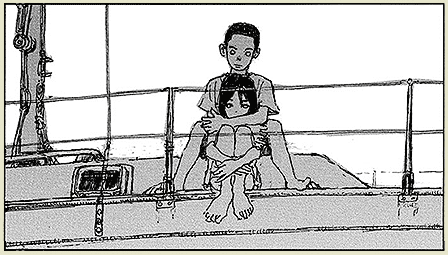
Easily the place where Igarashi's illustrations are most powerful is in his depiction of the seas and the lives and worlds they hold. His seascapes are lush and the variety of sealife he grants panel time is extraordinary. He draws his protagonists, each of whom have extraordinary capacities for undersea maneuvering, engaged in a near constant ballet with their aquatic hosts. It's delicate and lovely and foreboding. I don't know if you've ever swum55Just a petty note: swum may be the stupidest-sounding word in the English language. Thank you. over deep waters, but even confident swimmers are often overcome by dread of the fathomless depths yawning darkly open beneath. The sea, for all its strange unknowableness, truly strikes the human creature with awe. And Igarashi captures the smallest fraction of this terror in his art (which is more than most any other artist I've encountered). It's the kind of feeling I think Lovecraft tries to feel his way toward when he describes the madness-inducing horror of his cosmic things. Or maybe it's Moses, peeking out from behind the rock at Yahweh's hindparts. In any case, that awe, terror, respect, and horror are present in Igarashi's illustrations—and I'm so grateful to have encountered a book that is able to convey at least some small measure of this way of seeing.
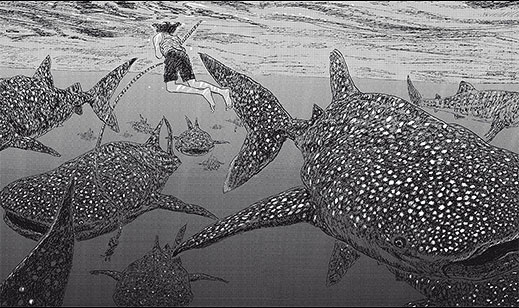
Children of the Sea's visual exploration is also incredibly detailed. Igarashi draws a lot of fish and draws them well. It took a long time for volume 5 to come out66Long enough so that I was worried that the series would be abandoned. VIZ's overlong silence on the matter wasn't encouraging either., but even a quick flipping through of its pages makes it obvious why that might be the case. Igarashi drew so, so much. Here is a small sample of pages:
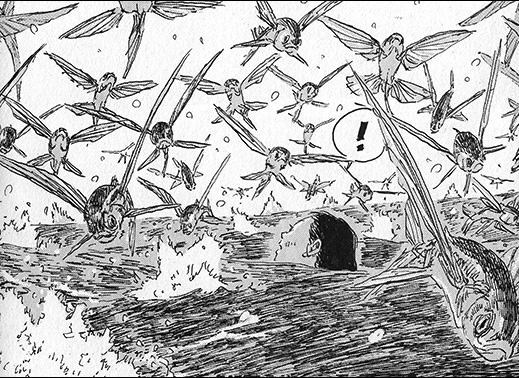

For all that though, part of the wonder of Children of the Sea is that it's more than just great art. This is a book of ideas, sometimes even big ideas. Even while proposing a fascinating cosmology, Children of the Sea starts off small, questioning the place of human primacy on the earth. There is a conversation in the middle of volume 3 that drives this home. Jim, an oceanic researcher, believes that Umi and Sora, while human, might be "special" in a manner similar to whales, whose cerebral cortices are much more developed than humans and whose peaceful lives might be devoted to thoughts entirely beyond the human enterprise. Dehdeh, a traditional navigator, counters his guess that either humans or whales are the special ones, pointing to the human propensity toward cataloguing and judging information based on what is analogous to our own experiences. By her watch, the human drive toward exhaustive taxonomy combines with our constant masquerading of subjective observation as objective experience to prevent us from recognizing the mysterious.
As Dehdeh broaches our fear of the numinous (a fear from which the horror of the depths I mentioned earlier derives) and our unwillingness to account for it within our daily paradigms, Igarashi's story continues to drive headlong into that kind of intangibility. Children of the Sea's central questions involve wondering at Sora and Umi's nature, wondering why such strange things are happening in the seas, and wondering ultimately at the part earth's unique seas play in the universe as a whole. And as if to drive home Igarashi's point that we are uncomfortable with that which lies beyond the empirical, reader reaction to how Children of the Sea answers these questions will (I would guess) be largely one of frustration. There are answers, certainly, but there remains an expansive sense of mystery.
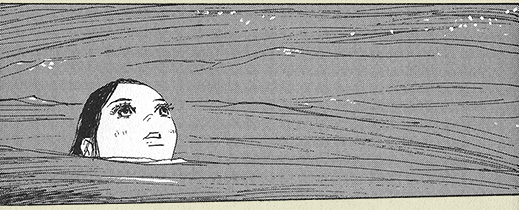
That the final volume of the series is largely wordless is evidence that Igarashi is less concerned with putting a bow on his neatly wrapped gift to us than he is in granting the reader the privilege of basking in a taste of the potentially deeply mystic nature of things. It's important that Igarashi leave us without the kind of concrete answers that we long for. Near the conclusion of the conversation in which Dehdeh expresses her thought that all species exist in a kind of universe-wide egalitarianism, Igarashi invokes Gödel's incompleteness theorem in a bid, I think, to prime the reader to recognize that the events in the book's conclusion will be beyond "reason." Later, Dehdeh expresses that people love to attach meaning to every little thing and that the most precious truths are best left unspoken, hinting that to describe them would be to bleach them of their preciousness.
Children of the Sea is a gradual and complicated work whose strengths probably most deeply lie in its mysteries. One needn't understand the link the book proposes between the cosmic and the marine to find spectacular value in Igarashi's vision. It may even be for the best if one doesn't. A better approach might be to simply enjoy the wonder of the seas as they unfold page after page through these five incredible volumes, and maybe use the discussions of metaphysics as springboard for personal reflection on the things that are just plain beyond us. Igarashi may actually have given us a perfect vessel for the consideration of the enigma of a world-cartography that cannot ever be entirely dependable. And I love him for that.
Good Ok Bad features reviews of comics, graphic novels, manga, et cetera using a rare and auspicious three-star rating system. Point systems are notoriously fiddly, so here it's been pared down to three simple possibilities:
3 Stars = Good
2 Stars = Ok
1 Star = Bad
I am Seth T. Hahne and these are my reviews.
Browse Reviews By
Other Features
- Best Books of the Year:
- Top 50 of 2024
- Top 50 of 2023
- Top 100 of 2020-22
- Top 75 of 2019
- Top 50 of 2018
- Top 75 of 2017
- Top 75 of 2016
- Top 75 of 2015
- Top 75 of 2014
- Top 35 of 2013
- Top 25 of 2012
- Top 10 of 2011
- Popular Sections:
- All-Time Top 500
- All the Boardgames I've Played
- All the Anime Series I've Seen
- All the Animated Films I've Seen
- Top 75 by Female Creators
- Kids Recommendations
- What I Read: A Reading Log
- Other Features:
- Bookclub Study Guides

